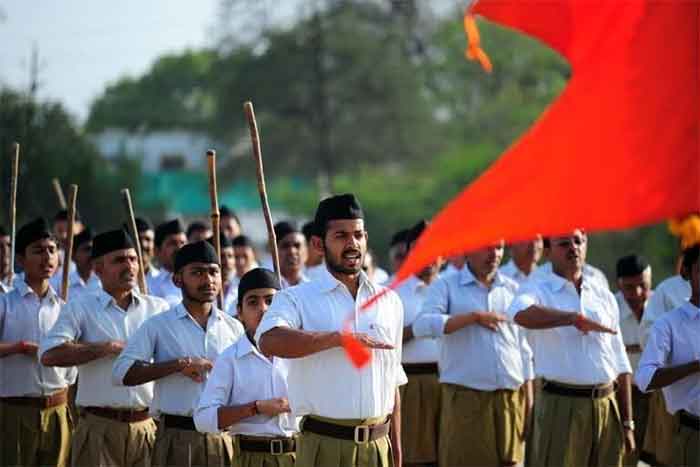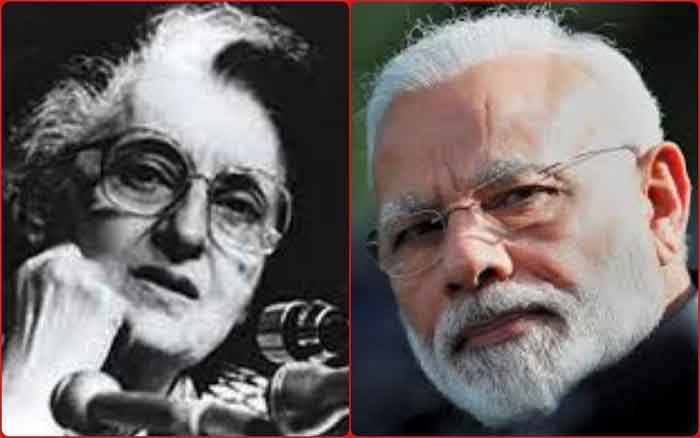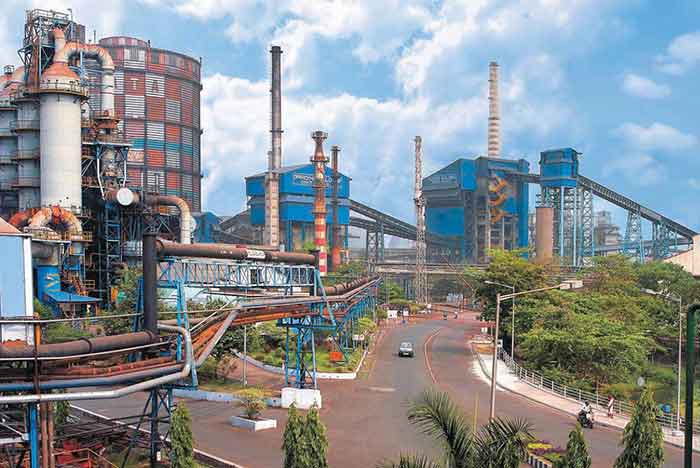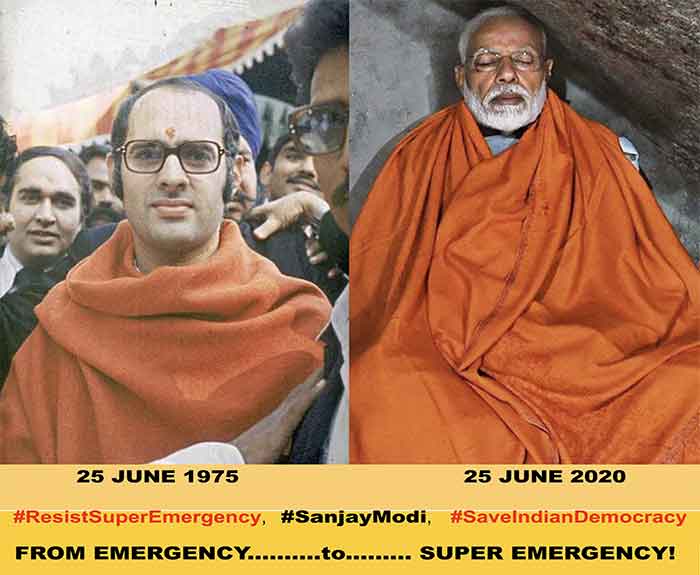
45 years prior to today, on June 26th 1975, the country awoke to a declaration of Internal Emergency. Arguably one of the darkest days in the country’s history post 1947, Emergency Rule imposed by the then central government led by Indira Gandhi’s faction of the Indian National Congress (INC) was characterised by a near complete suspension of basic democratic rights and targeted attacks on all progressive and democratic forces and organisations. Even forces of reaction serving the ruling class that were unaligned with Indira Gandhi’s clique suffered with some facing incarceration. But the brunt was borne by those sections of the people long opposed to the ruling classes, i.e. the workers, peasants, progressive students and intellectuals, trade unionists and religious minorities notably Muslims and Sikhs. They were subjected to killings, mass arrests, mass displacement from homes, forced sterilization campaigns and other measures. The 21 months of tyranny and the years succeeding it had a distinct impact on the country. While Indira Gandhi’s faction of the INC was defeated in the elections succeeding the lifting of Emergency Rule in 1977, the victorious hodge-podge Janata Alliance, markedly included the political wing of the RSS. Despite the change in government, economic policies implemented during Emergency largely continued under the Janata Alliance, enabling the ruling classes to continue appropriating a greater share of the pie while the crackdown on workers’ and peasant movements had weakened resistance resulting in widespread and intensifying immiseration and expropriation. Instability in the ranks of the Janata Alliance, attributable in some part to its fascist constituents, saw its collapse in less than three years and the return to power of Indira Gandhi’s faction of the INC. The presence of fascist organisations espousing Brahmanical Hindutva in the central government between 1977 and 1980 and the electoral legitimacy gained as a result alongside the rapid return of forces that imposed the Emergency Rule intensified the deterioration of the country’s democratic ethos, which had already weakened under the Emergency. It also affirmed that the ruling classes would maintain control through any means available. The forces in power today, dictating the nature of the Indian State and blatantly assaulting the most fundamental democratic rights emerge from this chasm that was gradually filled and fostered by feeding into the fractures in society on class, caste and communal lines.
The material basis for the emergence of the period of Emergency can be located in the crisis of the period preceding it. The early five-year plans, focused primarily on aggregate growth, failed in providing the toiling masses with any semblance of a dignified existence while the deceitful scuttling of land reform left the peasant’s thirst for land and an escape from the landlord’s control unquenched. The rise in the number of people under poverty, the stagnant wages, rising food prices, increasing unemployment and the successive monsoon failures in the decade preceding the Emergency resulted in widespread social unrest. Strikes increased in frequency and intensity across sectors including the railway, police and the Navy. Side by side, peasant revolt broke out in the East and the South, threatening not only landlords but also the State. Even student agitations, particularly in Bihar, emerged. The State confronted these struggles with not only brutal attacks but also by encouraging fascist elements to whip-up communal strife as in Jabalpur, Meerut, Aligarh, Kolkata, Rourkela, Ranchi, Karimganj, Ahmedabad and Bhiwandi. Despite militant struggles, poverty and inequality increased which combined with the global Oil Crisis of the 1970s led to a decline in the growth. The need to revive profits over the backs of militant workers and peasants was instrumental in eliciting the support of the ruling classes for Indira Gandhi’s coup. They were amply rewarded with a slew of measures including the banning of strikes, support for large scale lay-offs, dismantling of licensing and tax concessions while populist policies with little material impact like the abolition of privy purses were promulgated to placate the masses.
The rise of what many today deem an undeclared emergency must similarly be traced to its material roots. The return of Indira Gandhi’s faction of the INC to power in 1980 witnessed the emergence of a structural shift in state policy which bloomed in the early 1990s as Liberalisation, Privatisation and Globalisation. These neoliberal policies have deteriorated the material conditions of the toiling masses and increased the wealth of the ruling classes. Antagonisms emerging from widening economic disparity called for a redoubling of earlier techniques of crushing resistance alongside the deployment of new methods. Direct assaults continued unabated while measures like contractualisation and out-sourcing were deployed to break organised workers. In the countryside, private interests with the aid of state forces engaged in the large-scale plunder of land and mineral resources degrading the existence of the peasantry and the most marginalised castes and communities. On the ideological spectrum, a perceptible change was witnessed in the overt state support to fascist forces inciting communal strife. Incidents of communal violence in Hyderabad, Aligarh, Jamshedpur, Moradabad, Biharsharif, Meerut, Nellie, Bombay-Bhiwandi, Delhi, Hashimpura, Bhagalpur, Kanpur, Ayodhya, Bombay, Godhra, Kandhamal, Muzaffarnagar and, most recently, the attack on the anti-CAA, NRC, NPR protestors in Delhi and UP, all contain the visible hand of the highest levels of the State. Besides providing a fillip to fascist forces in orchestrating their communal activities, the propagandistic boost received from blurring the lines between fascist forces and the State has helped spread Brahmanical Hindutva, the ideology of Indian Fascism. This has helped draw more and more supremacist, chauvinist and masculinist elements into the fascist fold while expanding its influence over the toiling masses.
The slow incubation of Brahmanical Hindutva Fascism, its long nurturing by the ruling classes and the support, tacit and explicit, it has received from all political outfits representing the ruling classes, till recently when it took charge of the State negates the need for Emergency Rule. Post the 2008 financial crisis, when crisis in the world economy curtailed the scope of domestic growth, the jingoistic creation of internal and external enemies and muscular nationalism replete with Brahmanism promoting the establishment of a Hindu Rashtra are aimed at suppressing the contradictions in society emanating from the exploitation of workers and loot and plunder of the land, livelihood and resources of the peasantry and the most marginalised castes and communities. Organisations like the RSS, VHP and Bajrang Dal, flooded with funds and support of the ruling classes, have doubled their chapters since 2009. They have even spread to 39 countries worldwide drawing support from the Hindu diaspora. These efforts culminated in the electoral victory of the BJP in 2014. This slow incubation is not an aberration but a gradual and natural progression to a new norm.
Detention and torture of countless political prisoners, forced sterilization campaigns primarily targeting the poor, destruction of slums and displacement of thousands, the suspension of fundamental rights including Article 19, curbs on the freedom of the press, use of public and private media for government propaganda, the control over the judiciary and the suspension of democratic processes including frequent recourse to ordinances for rule by decree, were some of the most visible aspects of the Emergency. In the years that followed, many of these aspects continued to manifest in the guise of policy. The attack on academics, activists, journalists, lawyers, peasants, students, trade unionists and workers, the repeated clampdown on peoples movements like the assertion by Adivasis, Dalits, Muslims and progressive organisations at Bhima Koregaon in 2018 resulting in the continued incarceration of 11 persons under UAPA, the complete clampdown in Kashmir following the abrogation of Article 370 in 2019 and, most recently, in the targeting of anti-CAA activists alongside the protection provided to the perpetrators of the North East Delhi pogrom, are some of the most apparent markers of the continuance of State actions that characterised the Emergency. Today, executive control over the judiciary, an aspect tightly contested in the last five decades, is once again raising its head with each judicial pronouncement. The media, almost entirely under the control of the ruling classes, speaks in unison to distract from the conditions of workers, peasants, marginalised castes and communities, oppressed nationalities and women. The COVID-19 pandemic and the sudden lockdown in its wake has left lakhs of workers without employment, income or shelter. The callous treatment meted out to workers struggling to return home when compared to the State’s assuaging of the concerns of employers alongside its efforts to dilute legal rights of workers starkly reveals its subservience to the ruling classes’ interest.
The declaration of the Emergency came in the wake of the inability the ruling classes to contend with struggles of the toiling masses and declining growth in the economy. Today, an emergency need not be declared. The ascent of Brahmanical Hindutva Fascism constitutes the rule of those who want to establish a Hindu Rashtra under the aegis of those who want to expand their exploitation of labour and the loot of land and other resources for profit. Any opposition to this rule meets state repression through arrests, lynching, displacement and open contempt for rights of the poorest and the most marginalised. In light of this, Campaign Against State Repression on the 45th anniversary of the imposition of the Emergency Rule calls on all its constituent organisations and all democratic and progressive organisations and forces to carry forward the struggle for upholding democratic rights and principles. Simultaneously, we must strengthen movements for unity across caste and community and the struggles for wages, land and livelihood. To break the march of brutal exploitation and loot, our unity is essential.
Campaign Against State Repression
(Organising Team: AISA, AISF, APCR, BCM, Bhim Army, Bigul Mazdoor Dasta, BSCEM, CEM, CRPP, CTF, Disha, DISSC, DSU, DTF, IAPL, IMK, Karnataka Janashakti, KYS, Lokpaksh, LSI, Mazdoor Adhikar Sangathan, Mazdoor Patrika, Mehnatkash Mahila Sangathan, Morcha Patrika, NAPM, NBS, NCHRO, Nowruz, NTUI, People’s Watch, Rihai Manch, Samajwadi Janparishad, Satyashodak Sangh, SFI, United Against Hate, WSS)
SIGN UP FOR COUNTERCURRENTS DAILY NEWSLETTER













































